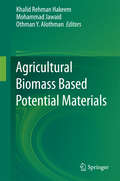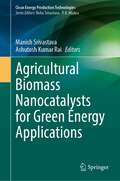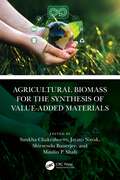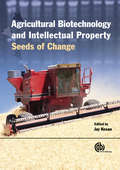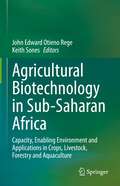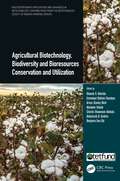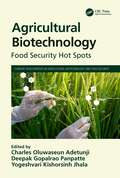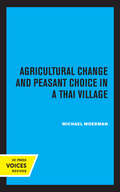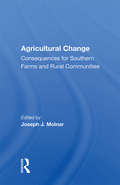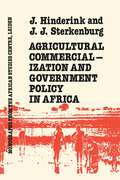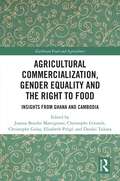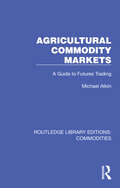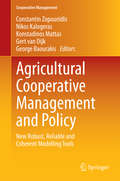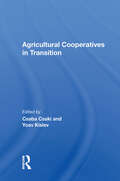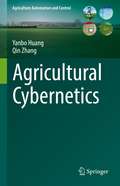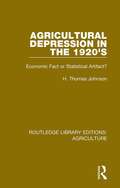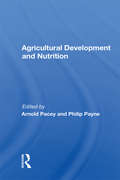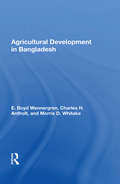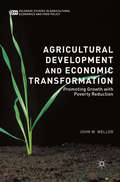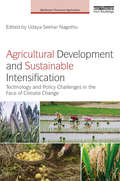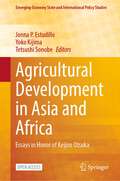- Table View
- List View
Agricultural Biomass Based Potential Materials
by Khalid Rehman Hakeem Mohammad Jawaid Othman Y. AlothmanAgricultural biomass is abundant worldwide and it can be considered as alternative source of renewable and sustainable materials which can be used as potential materials for different applications. Despite this enormous production of agricultural biomass, only a small fraction of the total biomass is utilized for different applications. Industry must be prepared to take advantage of the situation and utilize the available biomass in the best possible manner. Agricultural biomass such as natural fibres has been successfully investigated as a great potential to be used as a renewable and sustainable materials for the production of composite materials. Natural fibres offer excellent specific properties and have potential as outstanding reinforcing fillers in the matrix and can be used as an alternative material for biocomposites, hybrid composites, pulp, and paper industries. Natural fibre based polymer composites made of jute, oil palm, flex, hemp, kenaf have a low market cost, attractive with respect to global sustainability and find increasing commercial use in different applications. Agricultural biomass based composites find applications in a number of fields viz. , automotive industry and construction industry. Future research on agricultural biomass-natural fibre based composites should not only be limited to its automotive applications but can be explored for its application in aircraft components, construction industry, rural housing and biomedical applications. In this book we will cover the chemical, physical, thermal, electrical, and biodegradability properties of agricultural biomass based composite materials and its different potential applications. The main goal of this volume is to familiarize researchers, scientists and engineers with the unique research opportunities and potentials of agricultural biomass based materials. Up-to-date information on alternative biomass utilization Academic and industry leaders discuss unique properties of biomass based composite materials Direct application of agricultural biomass materials as sustainable and renewable alternatives
Agricultural Biomass Nanocatalysts for Green Energy Applications (Clean Energy Production Technologies)
by Manish Srivastava Ashutosh Kumar RaiThe book discusses the various sustainable approaches to combine agrowaste and nanomaterials into catalysts or nanocatalysts with the objective of enhancing biofuel production. It explores the practical sustainability of agronanocatalysts in bioenergy production at a mass scale, while also addressing the existing challenges and proposes sustainable remedies to overcome these limitations. Additionally, the book dives into the cost considerations, recognizing it as a major concern for the widespread utility of catalysts, and explores viable commercial applications in this context.Nanomaterials continue to attract attention in the field of proteins and enzymes due to their versatile physicochemical properties and potential. They offer opportunities to enhance various biofuel production processes by serving as catalysts in the reaction medium. For instance, studies have highlighted the significant improvements in cellulase enzyme production, stability, pretreatment of lignocellulosic biomass, and enzymatic hydrolysis efficiency achieved through the utilization of nanomaterials. The impact of nanomaterials on fermentative hydrogen production has also been documented. While the application of nanomaterials in biofuel production processes has been reported in the literature, there remains a need to focus on the type of nanomaterials, their synthesis, and their specific effects on important process parameters. Addressing and evaluating these factors is crucial to effectively improve and streamline biofuel production processes using nanomaterials. The book serves as a comprehensive introduction to nanomaterials and nanotechnology in biofuel production, catering to the needs of researchers, academicians and students.
Agricultural Biomass for the Synthesis of Value-Added Materials
by Maulin P. Shah Sankha Chakrabortty Jayato Nayak Shirsendu BanerjeeThis book is a comprehensive guide to bioconversion approaches based on microorganisms and enzymes for the valorization of underused wastes of diverse categories to produce new products. Optimized conditions for microbial and enzymatic valorization are discussed, along with related biotechnological considerations, environmental considerations, bioprocess development, obstacles, and future outlooks. Biofuels, bioenergy, and other platform chemicals are only some of the products that can be produced through this book's explanation of the microbiological processes involved in the bioconversion and valorization of wastes.
Agricultural Biotechnology and Intellectual Property: Seeds of Change
by Jay P. KesanThis volume addresses the intersection of agricultural biotechnology with intellectual property rights (IPRs) from a number of diverse perspectives.
Agricultural Biotechnology in Sub-Saharan Africa: Capacity, Enabling Environment and Applications in Crops, Livestock, Forestry and Aquaculture
by John Edward Otieno Rege Keith SonesThis book offers a comprehensive analysis of the application level for various agricultural biotechnologies across Sub-Saharan Africa. The authors examine the capacity available as well as the enabling environment, including policy and investments, for facilitating agricultural biotechnology development and use in the region. For each Sub-Saharan country, the status of biotechnology application is assessed in four major sectors; Crops, Livestock, Forestry and Aquaculture. Examples such as the number and requisite skill levels of trained personnel, biosafety frameworks and public awareness are surfaced in these chapters. This work also discusses the impact of push-pull factors on research, training and food security and identifies opportunities for investment in biotechnology and local agribusiness.Development partners, policy makers, agricultural consultants as well as scientists and private sector investors with an interest in biotechnology initiatives in Sub-Saharan Africa will find this collection an important account to identify key gaps in capacity and policy, as well as priority areas going forward. The volume highlights ways to develop technology and increase agricultural production capacity through international cooperation and inclusive economic growth, making it a valuable practice guide in line with the UN Sustainable Development Goals, in particular SDG 2 Zero Hunger and SDG 8 Decent Work and Economic Growth. Clear case studies round off the reading experience.
Agricultural Biotechnology, Biodiversity and Bioresources Conservation and Utilization (Multidisciplinary Applications and Advances in Biotechnology)
by Charles Oluwaseun Adetunji Abdulrazak B. Ibrahim Benjamin Ewa Ubi Olawole O. Obembe Abubakar Gidado Emmanuel Olufemi Ekundayo Arinze Stanley OkoliThis book covers a range of important topics on crop and animal genetics, breeding and genomics, as well as biodiversity and genetic resources conservation and utilization reflecting three thematic sections of working groups of the Biotechnology Society of Nigeria. The topics range from agricultural biotechnology, including genetically modified organisms and gene-editing for agronomically important traits in tropical crops, to Nigeria’s mega biodiversity and genetic resources conservation. This book will engender a deeper understanding of underpinning mechanisms, technologies, processes and science–policy nexus that has placed Nigeria as a leader in biotechnology in Africa. The book will be useful reference material for scientists and researchers working in the fields of food and agricultural biotechnology, bioinformatics, plant and animal genetics, breeding and genomics, genetic resources conservation and enhancement. Emphasizes recent advances in biotechnologies that could ameliorate the high-level global food and nutrition insecurity through plant and animal genetics, breeding, as well as genomics Provides detailed information towards harnessing indigenous bioresources for food and nutrition security and climate change adaptation Introduces new frontiers in the area of genomics, most especially their relevant applications in crop and animal breeding Reviews biotechniques that could enhance plant genetic resources conservation and utilization Discusses current biotechnological approaches to exploit genetic resources including the development of synthetic hexaploid wheat (SHW) for crop adaptation to the increasingly changing global climate
Agricultural Biotechnology: Food Security Hot Spots (Current Developments in Agricultural Biotechnology and Food Security)
by Charles Oluwaseun Adetunji Deepak Gopalrao Panpatte Yogeshvari Kishorsinh JhalaThis book presents strategies and techniques highlighting the sustainability and application of microbial and agricultural biotechnologies to ensure food production and security. This book includes different aspects of applications of Artificial Intelligence in agricultural systems, genetic engineering, human health and climate change, recombinant DNA technology, metabolic engineering and so forth. Post-harvest extension of food commodities, environmental detoxification, proteomics, metabolomics, genomics, bioinformatics and metagenomic analysis are discussed as well. Features: Reviews technological advances in microbial biotechnology for sustainable agriculture using Artificial Intelligence and molecular biology approach. Provides information on the fusion between microbial biotechnology and agriculture. Specifies the influence of climate changes on livestock, agriculture and environment. Discusses sustainable agriculture for food security and poverty alleviation. Explores current biotechnology advances in food and agriculture sectors for sustainable crop production. This book is aimed at researchers and graduate students in agriculture, food engineering, metabolic engineering and bioengineering.
Agricultural Biotechnology: Latest Research and Trends
by Pankaj Kumar Ajay Kumar Thakur Dinesh Kumar SrivastavaThis book caters to the need of researchers working in the ever-evolving field of agricultural biotechnology. It discusses and provides in-depth information about latest advancements happening in this field. The book discusses evolution of plant tissue culture techniques, development of doubled haploids technology, role of recombinant-DNA technology in crop improvement. It also provides an insight into the global status of genetically modified crops, use of RNAi technology and mi-RNAs in plant improvement. Chapters are also dedicated for different branches of ‘omics’ science including genomics, bioinformatics, proteomics, metabolomics and phenomics along with the use of molecular markers in tagging and mapping of various genes/QTLs of agronomic importance. This book also covers the role of enzymes and microbes in agriculture in productivity enhancement. It is of interest to teachers, researchers of biotechnology and agriculture scientists. Also the book serves as additional reading material for undergraduate and postgraduate students of biotechnology, agriculture, horticulture, forestry, ecology, soil science, and environmental sciences. National and international biotechnologists and agricultural scientists will also find this to be a useful read.
Agricultural Change and Peasant Choice in a Thai Village
by Michael MoermanThis title is part of UC Press's Voices Revived program, which commemorates University of California Press’s mission to seek out and cultivate the brightest minds and give them voice, reach, and impact. Drawing on a backlist dating to 1893, Voices Revived makes high-quality, peer-reviewed scholarship accessible once again using print-on-demand technology. This title was originally published in 1968.
Agricultural Change: Consequences For Southern Farms And Rural Communities
by Joseph J. MolnarThis book examines the impact of the rise and fall of new commodities, production technologies, and shifting government policies on individuals and farm families in the rural South and the interrelationship between agricultural change and community change.
Agricultural Commercialization And Government Policy In Africa
by HinderinkFirst published in 1987. Routledge is an imprint of Taylor & Francis, an informa company.
Agricultural Commercialization And Government Policy In Africa
by J. Hinderink J.J. SterkenburgFirst published in 1987. The object of this book is to show the nature and the constraints of the commercialization of agriculture in one of the world's major problem areas, Sub-Saharan Africa. Agricultural commercialization started here centuries ago, albeit in small, pockets. It expanded sharply during the colonial period when the sub-continent became integrated into the world's economy. After independence the nature of this integration did not structurally change and the basic characteristics o agricultural commercialization remained unaltered. After an analysis of this process during the colonial period, the study focuses on post-colonial government policies and on spatial variation in the commercialization of Africa's agriculture. Differences in environmental and socio-economic conditions, production performance and government policy are dealt with on two geographical scales: in the fist at the level of macro-regions and individual countries, and the second, by means of case studies at the regional, village and project level. Thee field-work based studies each centre on a specific aspect of commercialization process in a wide variety of countries, viz Swaziland, Sudan, Botswana, Ivory Coast, Mali and Kenya. The final part of the book relates the subject of commercialization and rural development to Africa's present agricultural crisis.
Agricultural Commercialization, Gender Equality and the Right to Food: Insights from Ghana and Cambodia (Earthscan Food and Agriculture)
by Christophe Golay Elisabeth Prügl Joanna Bourke Martignoni Christophe Gironde Dzodzi TsikataThis volume explores agricultural commercialization from a gender equality and right to food perspective. Agricultural commercialization, involving not only the shift to selling crops and buying inputs but also the commodification of land and labour, has always been controversial. Strategies for commercialization have often reinforced and exacerbated inequalities, been blind to gender differences and given rise to violations of the human rights to food, land, work and social security. While there is a body of evidence to trace these developments globally, impacts vary considerably in local contexts. This book systematically considers these dynamics in two countries, Cambodia and Ghana. Profoundly different in terms of their history and location, they provide the basis for fruitful comparisons because they both transitioned to democracy in the early 1990s, made agricultural development a priority, and adopted orthodox policies of commercialization to develop the sector. Chapters illustrate how commercialization processes are gendered, highlighting distinctive gender, ethnic and class dynamics in rural Ghana and Cambodia and the different outcomes these generate. They also show the ways in which food cultures are changing and the often-problematic impact of these changes on the safety and quality of food. Specific policies and legal norms are examined, with chapters addressing the development and implementation of frameworks on the right to food and land administration. Overall, the volume brings into relief multiple dimensions shaping the outcomes of processes of commercialization, including gender orders, food cultures, policy translation, national and sub-national policies, corporate investments and programmes, and formal and informal legal norms. In doing so, it offers insight not only on our case countries, but also provides proposals to advance rights-based research on food security. This book will be of great interest to students and scholars of food security, agricultural development and economics, gender, human rights and sustainable development.
Agricultural Commodity Markets: A Guide to Futures Trading (Routledge Library Editions: Commodities #2)
by Michael AtkinOriginally published in 1989, this book is a clear and thorough guide to the workings and purpose of the futures markets. It begins by explaining the role of futures and options in agriculture and their uses in reducing risks and maximizing profits. The state of the futures industry in the USA, Europe, Japan and the smaller exchanges elsewhere during the 1980s is examined, the pattern of price movements analysed, and the major background factors which influence price movements discussed. The regulatory environment in the US and UK is analysed, and there is a thorough explanation of fundamental and technical approaches to price forecasting and of strategies to maximize profits from trading. Detailed profiles of the major agricultural commodities traded on futures markets comprise the second part of this comprehensive handbook. The major markets, price movements, and trading opportunities are outlined for each commodity in turn. The book concludes by discussing the contemporary issues facing futures trading, and the role of the markets in the agricultural trade of developing countries.
Agricultural Cooperative Management and Policy: New Robust, Reliable and Coherent Modelling Tools (Cooperative Management)
by Constantin Zopounidis Konstadinos Mattas Nikos Kalogeras Gert Dijk George BaourakisThis book focuses on the use of farm level, micro- and macro-data of cooperative systems and networks in developing new robust, reliable and coherent modeling tools for agricultural and environmental policy analysis. The efficacy of public intervention on agriculture is largely determined by the existence of reliable information on the effects of policy options and market developments on farmers' production decisions and in particular, on key issues such as levels of agricultural and non-agricultural output, land use and incomes, use of natural resources, sustainable-centric management, structural change and the viability of family farms. Over the last years, several methods and analytical tools have been developed for policy analysis using various sets of data. Such methods have been based on integrated approaches in an effort to investigate the above key issues and have thus attempted to offer a powerful environment for decision making, particularly in an era of radical change for both agriculture and the wider economy.
Agricultural Cooperatives In Transition
by Csaba Csaki Yoav KislevOriginally published in 1993, this is a study of agricultural co-operatives. The farming structure in transition countries has shifted from dominance of large corporate farms to family smallholdings. Smallholders everywhere experience difficulties with access to market services, including sale of products, purchase of inputs, and acquisition of machinery; they suffer from credit shortages and have limited access to information and advisory services. The barriers to market access prevent smallholders from fully exploiting their inherent productivity advantages. Best-practice world experience highlights farmers' service cooperatives, created by grassroots users, as the most effective way of improving the market access of small farmers. Service cooperatives also help smallholders overcome market failures, when private business entrepreneurs are unwilling to provide services in areas that they judge unprofitable or unfairly exploit users through monopolistic practices. These difficulties and market failures are prominent in transition countries and scholars accordingly expected rapid development of agricultural service cooperatives in response to smallholder needs. The present volume explores gaps between expectations and reality.
Agricultural Crop Improvement: Plant and Soil Relationships (Exploring Medicinal Plants)
by Azamal HusenLarger amounts of nutritious food are required to feed the growing world population, which is a great challenge due to water shortages and reduced crop plant yield. To overcome this issue, there must be improvement in crop plant production systems. Agricultural Crop Improvement: Plant and Soil Relationships addresses key issues of crop plant yield and production, with molecular and physiological interventions to evolve future strategies that will overcome these challenges faced by the agricultural sector.Features Investigates modern and traditional agricultural techniques, including nanomaterials, nanosensors, genetic engineering, molecular breeding, nutrient and plant hormone interactions, microbiome engineering, soil enzymes, biostimulants, and intercropping Explores how technologies and scientific advancements from biotechnology, information technology, and environmental science are revolutionizing sustainable farming practices Agricultural Crop Improvement: Plant and Soil Relationships is a valuable source of information for researchers and extension workers involved in sustainable crop plants improvement and practices, and a useful resource for students and scientists working on aspects of agriculture, botany, plant science, crop physiology, crop biotechnology, and microbiology.
Agricultural Cybernetics (Agriculture Automation and Control)
by Qin Zhang Yanbo HuangAgricultural systems are uniquely complex systems, given that agricultural systems are parts of natural and ecological systems. Those aspects bring in a substantial degree of uncertainty in system operation. Also, impact factors, such as weather factors, are critical in agricultural systems but these factors are uncontrollable in system management. Modern agriculture has been evolving through precision agriculture beginning in the late 1980s and biotechnological innovations in the early 2000s. Precision agriculture implements site-specific crop production management by integrating agricultural mechanization and information technology in geographic information system (GIS), global navigation satellite system (GNSS), and remote sensing. Now, precision agriculture is set to evolve into smart agriculture with advanced systematization, informatization, intelligence and automation. From precision agriculture to smart agriculture, there is a substantial amount of specific control and communication problems that have been investigated and will continue to be studied.In this book, the core ideas and methods from control problems in agricultural production systems are extracted, and a system view of agricultural production is formulated for the analysis and design of management strategies to control and optimize agricultural production systems while exploiting the intrinsic feedback information-exchanging mechanisms. On this basis, the theoretical framework of agricultural cybernetics is established to predict and control the behavior of agricultural production systems through control theory.
Agricultural Depression and Farm Relief in England 1813-1852
by Leonard P. AdamsThis book was first published in 1932.
Agricultural Depression in the 1920's: Economic Fact or Statistical Artifact? (Routledge Library Editions: Agriculture #1)
by Thomas H. JohnsonFirst published in 1985. This study explores the agricultural depression in the United States of America in the 1920’s. The author examines overproduction, wartime optimism and the farm crisis, and continuity and change in agriculture during this period. This title will be of great interest to students of history, agriculture, and economics.
Agricultural Development And Nutrition
by Arnold Pacey Philip PayneThis book is an expose of the many food consumption-related problems which need to be considered alongside agricultural production issues in development. It examines factors that determine the degree to which people have access to food and can assimilate its nutrients.
Agricultural Development In Bangladesh: Prospects For The Future
by E. Boyd WennergrenThe performance of the agricultural sector and other related areas of the economy of Bangladesh are assessed in this book, which includes descriptions and analyses of Bangladesh’s natural and human resource bases; trends in agricultural input use and production of major crops; the agricultural marketing system; public sector interventions, organization, and financing; donor programs; and the agricultural research, extension, and educational systems. The authors identify positive factors contributing to sectoral growth and development as well as specific constraints to progress and conclude by offering an overall development strategy for achieving increased agricultural productivity, complete with specific policy and programming recommendations.
Agricultural Development and Economic Transformation: Promoting Growth with Poverty Reduction (Palgrave Studies in Agricultural Economics and Food Policy)
by John W. MellorThis book examines the role of agriculture in the economic transformation of developing low- and middle-income countries and explores means for accelerating agricultural growth and poverty reduction. In this volume, Mellor measures by household class the employment impact of alternative agricultural growth rates and land tenure systems, and impact on cereal consumption and food security. The book provides detailed analysis of each element of agricultural modernization, emphasizing the central role of government in accelerated growth in private sector dominated agriculture. The book differs from the bulk of current conventional wisdom in its placement of the non-poor small commercial farmer at the center of growth, and explains how growth translates into poverty reduction. This new book is a follow up to Mellor's classic, prize-winning text, The Economics of Agricultural Development.
Agricultural Development and Sustainable Intensification: Technology and Policy Challenges in the Face of Climate Change (Earthscan Food and Agriculture)
by Udaya Sekhar NagothuSustainable Intensification (SI) has recently emerged as a key concept for agricultural development, recognising that yields must increase to feed a growing world population, but it must be achieved without damage to the environment, on finite land resources and while preserving social and natural capital. It also recognises that all initiatives must cope with the challenges of climate change to agricultural production, food security and livelihoods. This multidisciplinary book presents state-of-the-art reviews of current SI approaches to promote major food crops, challenges and advances made in technology, and the institutional and policy measures necessary to overcome the constraints faced by smallholder farmers. Adressing the UN's Sustainable Development Goal 2, the various chapters based on evidence and experiences of reputed researchers show how these innovations, if properly nurtured and implemented, can make a difference to food and nutrition security outcomes. Case studies from around the world are included, with a particular emphasis on Asia and Sub-Saharan Africa. The focus is not only on scientific aspects such as climate-smart agriculture, agroecology and improving input use efficiency and management, but also on institutional and policy challenges that must be met to increase the net societal benefits of sustainable agricultural intensification. The book is aimed at advanced students and researchers in sustainable agriculture and policy, development practitioners, policy makers and non-governmental and farmer organisations.
Agricultural Development in Asia and Africa: Essays in Honor of Keijiro Otsuka (Emerging-Economy State and International Policy Studies)
by Tetsushi Sonobe Jonna P. Estudillo Yoko KijimaThis Open Access book explores the multifaceted nature of agricultural and rural development in Asia and examines the extent to which the Asian experience is being replicated in contemporary Africa. This volume compiles the works of top scholars who provided analyses and evidences from household-level surveys collected for many years in several parts of Asia and Africa. The most important finding presented in this book is that African agricultural development has evolved following the pathways of Asian agricultural development. The common pathways are borrowed technology from abroad and adaptive research in rice farming; secured property rights on natural resources; adoption of ICTs; investments in human capital, including training; and launching of the high-value agriculture. In both continents, agricultural development started in the crop sector, which had a strong tendency to induce the dynamic development of other sectors in rural areas.
